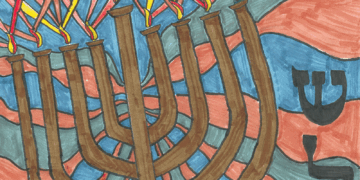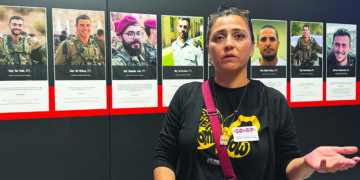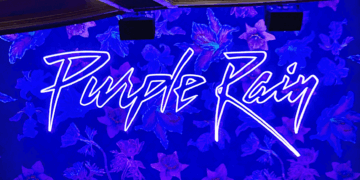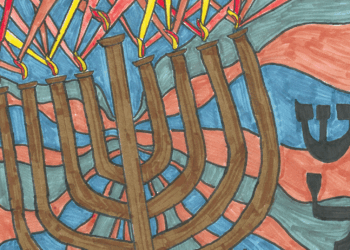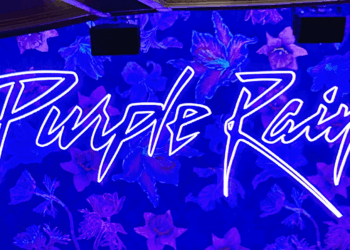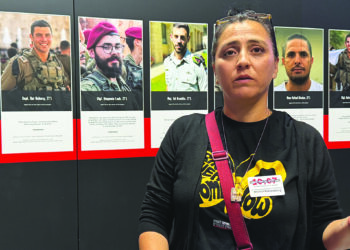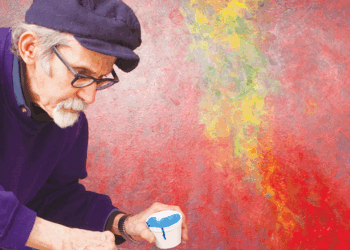By DORIS RUBENSTEIN
The Sabbath Now is a small installation that has recently been added to the permanent collection at the Minneapolis Institute of Art (Mia). While it is on exhibit in the Judaica gallery, the installation itself actually was donated to Mia’s Department of Textiles and Fiber Art, and for good reason: the sculptures that compose the installation actually are made from hand-crocheted thread by the artist Norma Minkowitz.
Born and raised in the Bronx, but living in Westport, Conn., for many years, Minkowitz was raised in a family that really didn’t observe the Sabbath much, so it was a challenge for her when she was invited to develop a piece of art with that theme for a show planned for 2013 at Philadelphia’s National Museum of American Jewish History.
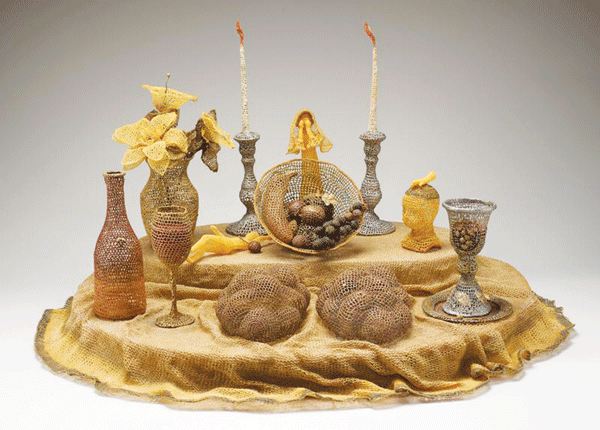
It took nearly two years of research for Minkowitz to research the traditions of Shabbat across time and various Jewish cultures. Her themes became The Sabbath Then (in the time of the Temple) and The Sabbath Now. Although Minkowitz’s original medium was drawing — she studied it at the Cooper Union in New York City — she extended the line created by the pen into multiple colors of cotton thread that she crocheted and then molded with resin into shapes that are sometimes familiar and other times strangely symbolic of what the Sabbath is to Jews.
“Drawing continues to be important to me and I find that the threads and wires I use mimic the cross hatching and irregularities of my pen and ink drawings,” Minkowitz explains. “My sculpture evolves into a three-dimensional drawing.”
Though it’s a small show, The Sabbath Now warrants more than a superficial glance to capture all of its messages and its medium. Looking closely at the tablecloth, you find the words “Sabbath” and “Manna” — the food provided by HaShem specifically for the Shabbat during the forty years in the desert — woven into its border. Each aspect of the Friday night celebration is represented in physical form, from the candles and the woman whose duty it is to bless them to a reclining figure who reminds us that this is a day of rest.
The amazing resemblance of the crocheted objects to the real things begs the question: How did she do that? Minkowitz shared her secret:
“Although my primary method of working is crochet, it is just a means to an end. The transparency of crochet allows me to best express my pursuits of forms that do not reveal themselves immediately, but draw the viewer to contemplate the meaning and mystery of nature, including human nature.” She goes on to describe: “As for my process, I crochet around objects as in the case for The Sabbath Now installation, which had specific objects that I researched and recreated in an open pattern which were replicas of the actual requirements for the contemporary Sabbath table.”
Given that Minkowitz donated The Sabbath Now (in memory of her machatunim Gussie and Meyer Minkowitz) for the Textile and Fiber Art Collection, is it too much of a coincidence that the large exhibit in the adjacent galleries, The Enduring Soul, features several pieces of textile and fiber art? Fans of this medium, once sated with The Sabbath Now, will want to wander through this show that presents creations by African and African-American artists who honor ancestors. Each of the six works on view expresses spiritual memory and personal responses to history and community experiences.
Taking the art and craft of crochet in a totally different direction, African-American artist Nick Cave’s Soundsuit (2010) is a journey into sound — using noisemakers of all kinds (Purim groggers?) and vibrant colors, particularly in the “second skin” that he created for his statue out of crocheted patchwork. Mia says “Cave’s first Soundsuit was created in the early 1990s in response to the racial profiling and beating of Rodney King in Los Angeles by police officers, and the subsequent riots. The Soundsuits have often been described as a protective ‘second skin.’ Cave’s creations allow the wearer to subsume their own identity and to adopt that of the sculpture/garment in a fusion of textile art, sculpture, and performance.”
It’s winter in Minnesota. Time to curl up for those who knit or crochet. These two exhibits will be running through spring. Take advantage of a warm day to get in the car and go to see the art of crochet in all its variety at Mia.


